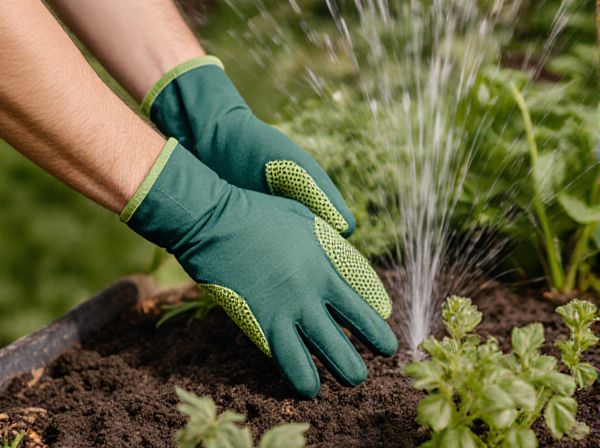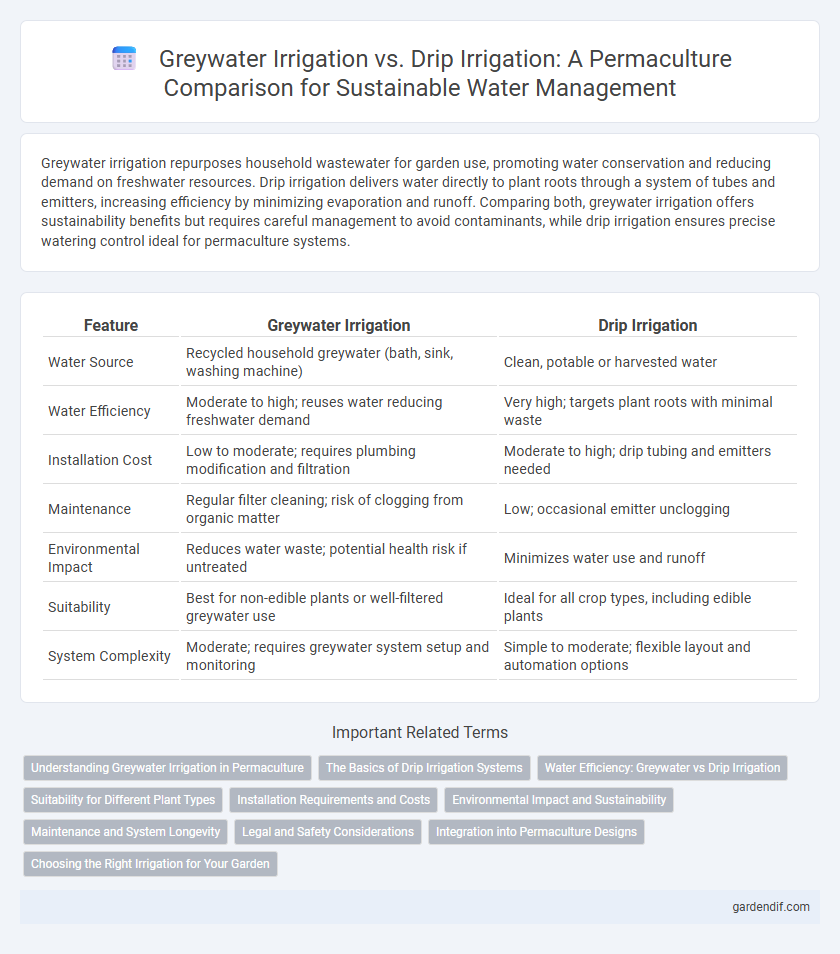
Greywater Irrigation vs Drip Irrigation Illustration
Greywater irrigation repurposes household wastewater for garden use, promoting water conservation and reducing demand on freshwater resources. Drip irrigation delivers water directly to plant roots through a system of tubes and emitters, increasing efficiency by minimizing evaporation and runoff. Comparing both, greywater irrigation offers sustainability benefits but requires careful management to avoid contaminants, while drip irrigation ensures precise watering control ideal for permaculture systems.
Table of Comparison
| Feature | Greywater Irrigation | Drip Irrigation |
|---|---|---|
| Water Source | Recycled household greywater (bath, sink, washing machine) | Clean, potable or harvested water |
| Water Efficiency | Moderate to high; reuses water reducing freshwater demand | Very high; targets plant roots with minimal waste |
| Installation Cost | Low to moderate; requires plumbing modification and filtration | Moderate to high; drip tubing and emitters needed |
| Maintenance | Regular filter cleaning; risk of clogging from organic matter | Low; occasional emitter unclogging |
| Environmental Impact | Reduces water waste; potential health risk if untreated | Minimizes water use and runoff |
| Suitability | Best for non-edible plants or well-filtered greywater use | Ideal for all crop types, including edible plants |
| System Complexity | Moderate; requires greywater system setup and monitoring | Simple to moderate; flexible layout and automation options |
Understanding Greywater Irrigation in Permaculture
Greywater irrigation in permaculture utilizes household wastewater from baths, sinks, and washing machines to nourish garden plants, reducing freshwater consumption and promoting sustainable water management. This method leverages nutrient-rich greywater to enhance soil fertility and plant growth while minimizing environmental impact. Proper system design ensures safe application by filtering and directing greywater to avoid root zone contact and potential health risks.
The Basics of Drip Irrigation Systems
Drip irrigation systems deliver water directly to the root zone of plants through a network of tubes, emitters, and valves, minimizing water waste and evaporation. This method ensures precise water application, improves plant health, and conserves resources by targeting specific areas rather than irrigating entire surfaces. In comparison to greywater irrigation, drip irrigation provides more control over water quality and timing, making it ideal for permaculture designs focused on efficiency and sustainability.
Water Efficiency: Greywater vs Drip Irrigation
Greywater irrigation repurposes household wastewater, reducing freshwater usage by recycling nutrients and moisture directly to plants, offering significant water savings in sustainable gardens. Drip irrigation delivers precise amounts of water directly to plant roots, minimizing evaporation and runoff, making it highly efficient in arid environments. Comparing water efficiency, greywater irrigation leverages recycled water resources, while drip irrigation optimizes freshwater use through targeted delivery, both essential for water conservation in permaculture systems.
Suitability for Different Plant Types
Greywater irrigation is highly suitable for drought-tolerant plants such as fruit trees, shrubs, and certain vegetables that can tolerate occasional exposure to mild contaminants. Drip irrigation excels with a wide range of plants, especially delicate herbs, leafy greens, and container plants, providing precise water delivery directly to the root zone, minimizing water waste and reducing disease risk. Selecting the appropriate irrigation method depends on plant sensitivity, soil type, and water quality to optimize growth and sustainability in permaculture systems.
Installation Requirements and Costs
Greywater irrigation systems require specialized filtration and plumbing modifications to safely reuse household wastewater, often involving higher initial installation costs compared to drip irrigation. Drip irrigation installation is typically simpler, relying on straightforward tubing and emitters, making it more cost-effective and easier to set up in most gardens. While greywater systems can reduce water bills and improve sustainability, their complexity and regulatory requirements usually lead to greater upfront expenses than conventional drip irrigation.
Environmental Impact and Sustainability
Greywater irrigation recycles household wastewater, reducing freshwater consumption and decreasing the volume of sewage entering treatment systems, thereby promoting resource conservation and lowering environmental pollution. Drip irrigation efficiently delivers water directly to plant roots, minimizing evaporation and runoff, which conserves water and reduces soil erosion. Combining greywater systems with drip irrigation enhances sustainable water management by maximizing reuse and optimizing water application, supporting permaculture's goal of ecological balance and resource efficiency.
Maintenance and System Longevity
Greywater irrigation systems require regular monitoring to prevent clogging and salt buildup, ensuring water quality does not harm plants or soil health. Drip irrigation needs frequent inspection of emitters for blockages and maintenance of filtration systems to maintain consistent water flow and prevent damage. Both methods benefit from routine maintenance, but drip systems generally offer longer system longevity due to their closed, controlled water delivery reducing wear and contamination risks.
Legal and Safety Considerations
Greywater irrigation systems must comply with local regulations that govern the reuse of household wastewater to prevent contamination and health risks, often requiring treatment or filtration before application. Drip irrigation, while generally considered safe and legal, must avoid overwatering to prevent root disease and nutrient runoff, ensuring sustainable water management. Adherence to municipal codes and environmental guidelines is critical for both methods to promote safe and effective permaculture water use.
Integration into Permaculture Designs
Greywater irrigation enhances permaculture designs by recycling household wastewater to nourish plants, reducing freshwater use while promoting sustainable water management. Drip irrigation offers precise water delivery to root zones, minimizing evaporation and runoff, making it efficient for plant health in arid zones. Integrating both methods maximizes water conservation, supports diverse plant species, and aligns with permaculture principles of closed-loop resource cycles.
Choosing the Right Irrigation for Your Garden
Greywater irrigation utilizes recycled household water to sustainably nourish plants, reducing overall water consumption and promoting eco-friendly gardening practices. Drip irrigation delivers precise water directly to the plant roots, enhancing water efficiency and minimizing evaporation and runoff. Selecting between greywater and drip irrigation depends on water source availability, garden plant types, and long-term sustainability goals within your permaculture design.
Greywater Irrigation vs Drip Irrigation Infographic

 gardendif.com
gardendif.com